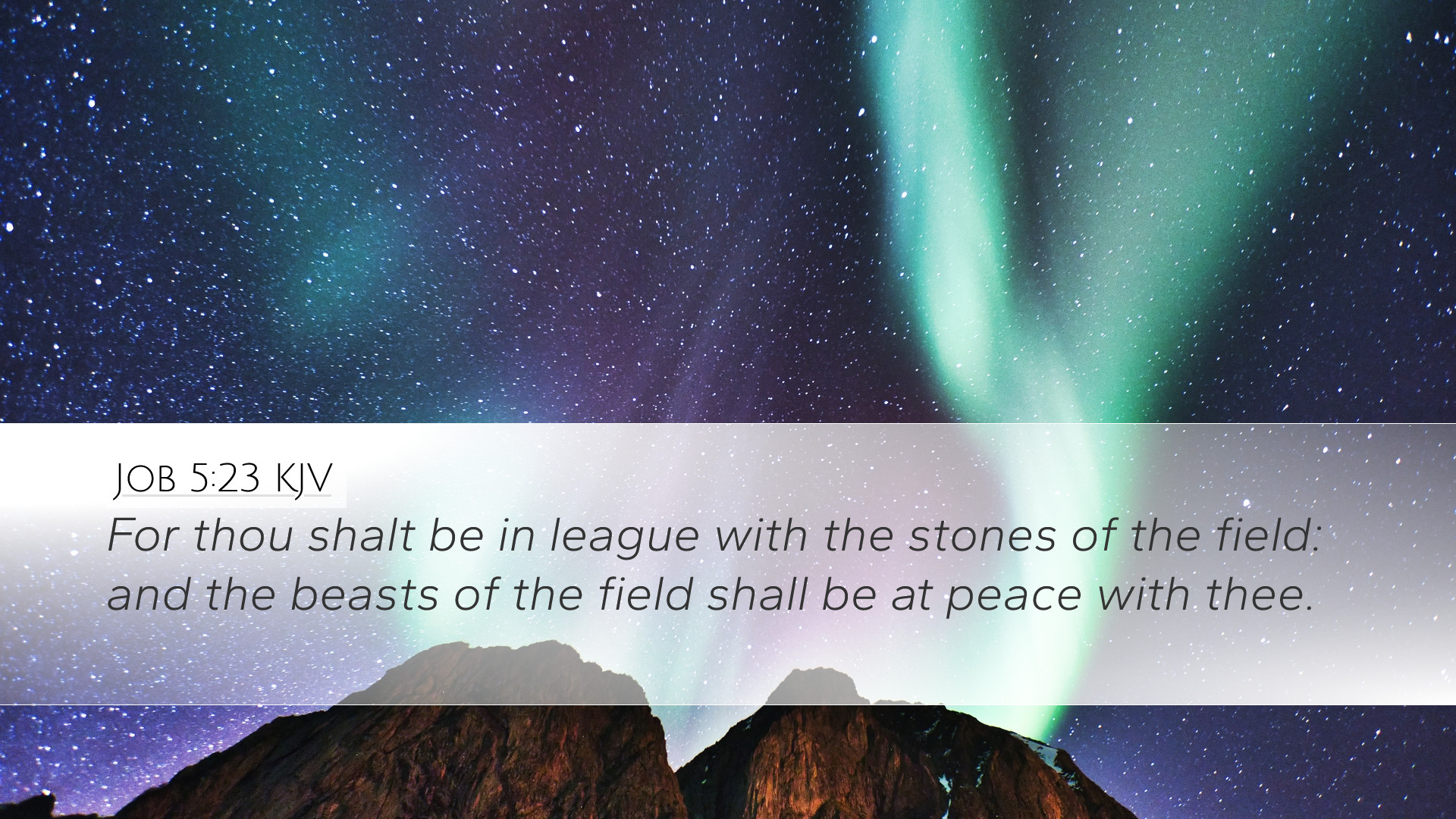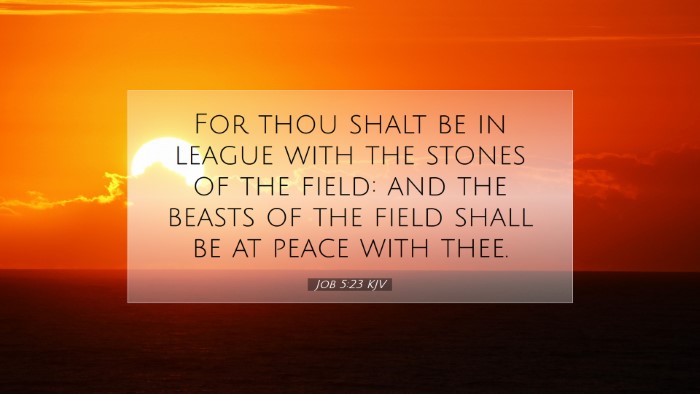Old Testament
Genesis Exodus Leviticus Numbers Deuteronomy Joshua Judges Ruth 1 Samuel 2 Samuel 1 Kings 2 Kings 1 Chronicles 2 Chronicles Ezra Nehemiah Esther Job Psalms Proverbs Ecclesiastes Song of Solomon Isaiah Jeremiah Lamentations Ezekiel Daniel Hosea Joel Amos Obadiah Jonah Micah Nahum Habakkuk Zephaniah Haggai Zechariah MalachiJob 5:23
Job 5:23 KJV
For thou shalt be in league with the stones of the field: and the beasts of the field shall be at peace with thee.
Job 5:23 Bible Commentary
Commentary on Job 5:23
Verse Text: "For thou shalt be in league with the stones of the field: and the beasts of the field shall be at peace with thee." (Job 5:23, KJV)
Introduction
The Book of Job addresses profound themes of suffering, divine justice, and human perplexity concerning God’s governance of the world. Job 5:23 is part of Eliphaz's discourse, where he conveys a vision of peace that accompanies those who are aligned with God. This commentary draws upon the insights of Matthew Henry, Albert Barnes, and Adam Clarke to explore the deeper implications of this verse.
Contextual Background
The context of this verse stems from Eliphaz the Temanite’s response to Job’s lamentations. Eliphaz emphasizes the assurance that comes from righteousness and faith in God. He views peace as a covenant between God’s followers and the natural world, which reflects God’s benevolence and the restored harmony in life.
Detailed Commentary
1. The Divine League with Creation:
Henry emphasizes that the phrase "in league with the stones of the field" signifies a profound alliance between the righteous and nature itself. This suggests that those who walk in accordance with God’s will experience a unique integration within creation, where even the seemingly inert and unfeeling elements of the earth respond positively to them.
Barnes expands on this idea by noting that the covenant implies protection and safety; the believer finds themselves in harmony not only with God but also with the environment. The imagery of stones can represent both stability and a solid foundation in faith.
2. Peace with the Beasts:
Eliphaz’s assertion that “the beasts of the field shall be at peace with thee” is explored by Clarke, who articulates that this peace signifies an overarching tranquility that governs all relationships. The phrase reflects a time when conflict between man and nature is resolved, symbolizing divine favor.
This peace alludes to a future eschatological vision where harmony prevails, resonating with the prophetic peace described in Isaiah 11:6-9. This points to a transformative effect of divine intervention, where the righteous live in harmony with all creation.
3. The Theological Implications:
Henry articulates that this verse illustrates the larger theological principles of divine protection and the restoration of order. It speaks to the character of God as one who desires a right relationship not only with humanity but with all of His creation.
Barnes notes that the emphasis on peace serves as a reminder of God’s intention for all of creation to coexist without hostility, reflecting His original design in the Garden of Eden before the fall.
Practical Applications
The verse serves as a profound reminder for believers today. From Eliphaz’s perspective, the assurance of peace and security leads to a life characterized by trust in God, even amidst trials.
- Faith and Assurance: Believers are encouraged to place their trust in God’s promises, understanding that a life aligned with His will secures divine support.
- Environmental Stewardship: The concept of being at peace with creation invites discussions on how Christians ought to care for the environment, recognizing our responsibility as stewards of God’s creation.
- Interpersonal Relationships: Peace with the “beasts” points towards the broader call to live peacefully with one another in the community and the world at large, reflecting the character of Christ.
Conclusion
Job 5:23 encapsulates a vision of harmonious coexistence that theologians and scholars alike can appreciate. As Eliphaz articulates the blessings bestowed upon the righteous, we are reminded of God’s overarching plan for peace and restoration, not only between man and God but also within creation itself. From the insights of Matthew Henry, Albert Barnes, and Adam Clarke, we glean a rich theological canvas that encourages deeper reflection on our relationship with the divine and the created order.


